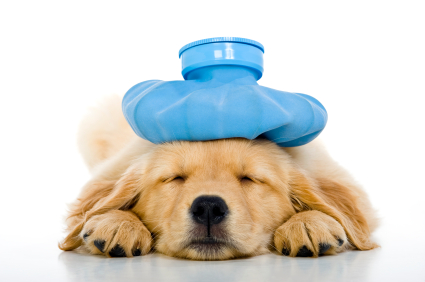Team:UIUC Illinois/Project/PuppyProbiotic
From 2014.igem.org
Puppy Probiotics.
"The art of research [is] the art of making difficult problems soluble by devising means of getting at them. "
An Introduction
Imagine...
Imagine drinking a cup of coffee. You stolidly sip your espresso and soon enough you feel a warm sensation cajole your body into getting that assignment done. However, you notice you're fidgeting uncontrollably, the room starts spinning and you begin to vomit. Ambulances, the noises are familiar, you've just seized. You're a dog.

What just happened?
Canines and many small animals are incapable of metabolizing theobromine and related stimulants as fast as humans can. Chocolate contains theobromine, an alkaloid that has stimulant properties. An excess of the stimulant builds up and begins to overstimulate the animal, thus leading to many malicious side effects. Ranging from slight nausea to death, consumption of these compounds are harmful for the animal. Chocolate can affect the animal regardless of the amount administered. Even the smallest amounts can produce side affects like diarrhea. In fact, theobromine has been employed to ward off pests of the same genus as canines: "Results indicate that mixtures of theobromine and caffeine have the potential to be developed into a selective, effective, and socially acceptable toxicant for the control of pest coyotes."[1] Caffeine in humans is degraded via a cascade mediated by Cytochrome P450. This is the primary molecule that allows for xanthine demethylation. In canines and smaller species, the cytochromes are available, however altered in a way that prevents caffeine degradation! Despite sequence homology to Human's P450, a canine's metabolism does not function similarly!

What can we do?
Problem solving
In effort to solve this problem, our team looked at the biological cascade of caffeine and theobromine. Since our goal was to degrade caffeine into something less harmful, we looked to digestion. We uncovered that theobromine can in fact be degraded into subtituents that are less harmful, namely a cascade that converts it to uric acid, a molecule that the dogs could excrete as waste

Nature's answer We discovered that the organism Pseudomonas putida CBB5 endogenously metabolized caffeine and subsequent methylxanthines. In fact, the organism degraded the compounds using the proteins NdmA (N-Demethylase A) and NdmB, both of which are Rieske nonheme iron monooxygenases, NdmC, another demethylase and NdmD, a reductase. By using this pathway, the organism is able to use caffeine as a carbon and nitrogen source.[2] Too good to be true? No. In fact, a previous iGEM team, UT Austin 2012 Caffeinated Coli, harnessed the power of this novel pathway in their own project! We were ecstatic to learn that the pathway was available in biobrick form and ready for us to manipulate.

UT Austin developed this part by rearranging the operon of CBB5 and developed this part:

By using this construct, we were eager to repurpose it to degrade theobromine. Degrading theobromine meant targeting the host where theobromine failed to be degraded. An enteric approach is what we chose, thus leading us to design a probiotic. We chose Latobacillus, specifically Lactobacillus Plantarum WCFS1 as our fermenter of choice. Our plan was to PCR out the genes corresponding to theobromine degradation (NdmB, NdmC, NdmD) and assemble that into a shuttle vector for Lactobacillus.
Plantarum to propagate the Puppy Probiotic How could we deliver our theobromine degrading enzymes to the gut of the host? We decided upon the ever increasingly popular probiotic. Probiotics are foods or supplements that harness microbes to produce products for a positive purpose. To create a probiotic, delivery of an organism was necessary. Lactobacillus Plantarum WCFS1 is a strain of Lactobacillus that is capable of surviving gut conditions as well as thriving in the endogenous microbiota of the organism it's in. By having Plantarum in the gut, we hoped that it would produce enzymes that could survive and propagate in the gut itself. Plantarum became the organism we decided to transform our products into.

 "
"







